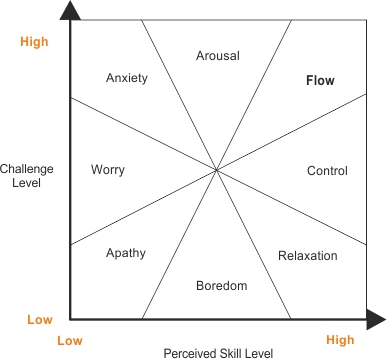| The Flow Model Balancing Challenge and Skills | |||
Everything around you - from the ringing of phones to the people passing in the hallways - seemed to fade away. Your attention was focused entirely on what you were doing, and you were so engaged that you might have missed lunch. You felt energized, even joyful, about what you were doing. Most of us have had this experience at one time or another, and psychologists call it "flow." When it happens, we lose our sense of self, and we move forward almost on instinct, completely devoted to the task before us. | |||
| In this article, we'll examine flow in detail by looking into the Flow Model. We'll explore how the model can help us understand why we find some tasks much easier than others. We'll also look at how you can use the ideas behind the Flow Model to experience flow more often, so that you can be more productive. The Flow Model The Flow Model (see figure 1, below) was first introduced by positive psychologist Mihaly Csikszentmihalyi. He wrote about flow in his book "Flow: The Psychology of Optimal Experience."
 The model shows the emotional states that we're likely to experience when trying to complete a task, depending on the perceived difficulty of the challenge and our perceptions of our skill levels. For example, if the task isn't challenging and doesn't require a lot of skill, we're likely to feel apathy towards it. But facing a challenging task without the required skills could easily result in worry and anxiety. To find a balance, and to perform at our best, we need a challenge that is significant and interesting, and we need well-developed skills, so that we're confident that we can meet the challenge. This moves us to a position where we can experience "flow" (being totally involved and engaged in the activity). This state of flow is often observed in people who have mastered their business, art, sport, or hobby. They make whatever they're doing look easy, and they're totally engaged with it. 10 Components of Flow How do you know when you're experiencing flow? Csikszentmihalyi identified 10 experiences that go with this state:
Three Conditions Csikszentmihalyi also identified three things that must be present if you want to enter a state of flow:
To improve your chances of experiencing flow, do the following:
The Inverted-U Model There's an overlap of ideas between the Flow Model and the Inverted-U Model - a popular and widely respected model that helps explain the relationship between performance and pressure. In the inverted-U graph, the vertical axis represents someone's level of performance, while the horizontal axis represents the pressure that he or she is under. According to the model, there's a "perfect medium" of pressure where people perform at their best. The Flow Model doesn't explain the loss of performance that occurs when pressure is too high - for example, when we're scared, or when we're overwhelmed by work. At these times, your productivity can drop and negative emotions like anxiety will increase dramatically. By using both of these models together, you're most likely to be able to enter and enjoy the state of flow. Key Points Flow is a state we enter when our perceived skills match the perceived challenge of the task that we're doing. When we're in a state of flow, we seem to forget time. The work we do may fill us with joy, and we lose our sense of self as we concentrate fully on the task. This is the state that we're in when we're doing our best work, and when we're at our most productive. The Flow Model shows the relationship between task complexity and your perceived skill level. You can use the model to find out why you're not achieving flow. It can also help you discover whether you need to improve your skills, or reduce the challenge of certain tasks, to help achieve flow. Origin: Mindtools.com Submit Your Post: http://www.lolstudent.com/p/submit-guest-post.html |











